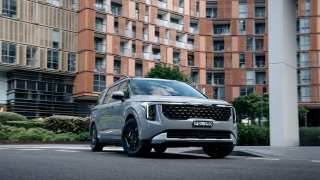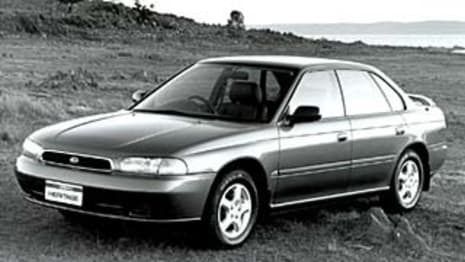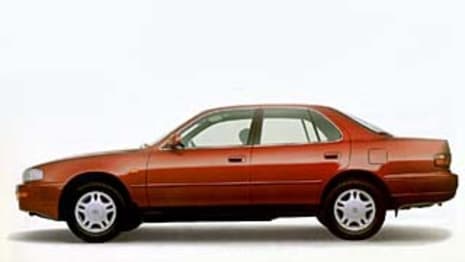
Used Subaru Liberty review: 1994-1998
- Subaru Liberty
- Subaru Liberty 1994
- Subaru Liberty 1995
- Subaru Liberty 1996
- Subaru Liberty 1997
- Subaru Liberty 1998
- Subaru Liberty Reviews
- Subaru Reviews
- Subaru Sedan Range
- Sedan
- Subaru
- Used Car Reviews
- Buying tips
There wasn’t much hoopla surrounding the launch of the second generation Subaru Liberty in 1994. The previous model was safe and solid without being particularly exciting, and there was no reason to believe the new one would be anything but a competent follow-up with the same attributes. It was all of that, but it was also much better, and cheaper to boot. By the time the year ended the Liberty was widely regarded as the best new car of the year.
By the mid-1990s Subaru was facing extinction. Its cars were sound, but it was a minnow in the car making world and really didn’t have the wherewithal to survive in a highly competitive industry that thrived on volume.
A switch to all-wheel drive exclusively across all models in the mid-1990s, the runaway popularity of the hot rally-bred WRX, and an alliance with General Motors which will see an evolution of the Subaru all-wheel drive system under the Commodore later this year, kept the bankers at bay and the company thriving.
MODEL WATCH
The second generation (2GEN) Liberty was new from the floorpan up. The chassis and floorpan were refined and improved, but essentially they were carried over from the previous model. The major changes to the underpinnings came from the increased wheelbase, which was 50 mm longer than the first generation model.
While the LIberty was attractive it wasn’t leading edge in styling terms, but that was what helped make it appealing to so many. It was inoffensive to everyone, while at the same time it looked sturdy and reliable.
The front-wheel drive LX opened the eight-model range which was topped by the all-wheel drive Heritage 4WD. Available body styles were a sedan and wagon.
The added 50 mm of wheelbase was put to good use with all of the stretch going to increase the rear seat room, which was generous to say the least. There was also a benefit for front seat occupants as Subaru fitted longer front seat runners that allowed the driver and front seat passenger to slide the front seats back further. That way it was possible for taller occupants to find a comfortable seating position.
Loads of space in the rear of the wagon, and a large boot in the sedan added to the Liberty’s attraction as a family car.
The stiffer body contributed to the Liberty’s praised ride and handling, which was enhanced by a package of well tuned springs and shocks for improved wheel control. Along with well weighted, precise power steering, the chassis package had road testers putting the Liberty near the top of its class.
An unusual exhaust note signalled that the Liberty had something different under the bonnet. On inspection you found it was a flat-four mounted at the front.
With a capacity of 2.2 litres the ‘boxer’ four produced 94 kW at 5200 revs and 190 Nm at 4400 revs, giving it quite reasonable performance. Performance was improved in 1996 when a larger 2.5-litre version of the flat-four became available.
Liberty buyers could choose between a five-speed manual gearbox and a four-speed auto, both of which were highly rated, and there was the choice of all-wheel drive.
The LX was equipped with standard air-conditioning, body coloured bumpers, power door mirrors, power steering and radio/cassette sound. Airbags and ABS were optional. The mid-range GX also had alloy wheels, central locking, cruise control, power antenna and power windows. The range-topping Heritage was only available with the auto trans, but also had standard ABS, dual airbags, CD player, remote central/keyless locking, leather trim and woodgrain. The sporty Rallye came with a body kit and fog lamps.
IN THE SHOP
Subaru build quality is rated highly, with tight body construction and even body gaps, so they develop few squeaks and rattles in service.
Owners and mechanics alike report few problems with Subarus in general, and the Liberty in particular, with most visits to the workshops being for regular scheduled service.
Tyre life is generally good, with owners reporting up to 75,000 km before tyres need to be replaced. Likewise brake life is reported as good.
Engines, transmissions and drive lines are all regarded as robust and reliable with few problems reported from the trade.
While the 4WD system is highly respected for its safe handling it should be understood that it is an added complication that can lead to greater repair costs if something does go wrong. Before rushing in and buying a 4WD think about your reasons for buying it.
A 4WD system will be a safer proposition in everyday driving, giving better grip and handling on slippery surfaces, it may well get you out of a dangerous system that a normal two-wheel drive system won’t. But don’t buy it expecting to be able to go off road, because that’s not what the Liberty is all about. Use the 4WD system for added on-road security, but don’t be tempted to go bouncing down rough bush tracks.
OWNERS SAY
Pete Minahan has done 60,000 km in the ’96 Liberty Wagon he bought in 2001, bringing it to 150,000 km in total, and he’s very happy with it. He praises its road manners, ride, and handling, and likes the all-wheel drive, but criticises its road noise and inadequate adjustment of the driver’s seat. He’s had to do nothing except the scheduled servicing.
Mitch Miller bought a manual Liberty GX in 1998 and says he hasn’t looked back. He reports that he regularly gets 8.1 L/100 km/h on country trips, with a low of 7.7 when using PULP.
Graham Stewart has had his 1995 Liberty one year and he’s very pleased with it. Now with got 270,000 km on the clock he says it’s quiet and smooth with plenty of pickup when needed.
Ron Co has owned a ’96 Liberty GX auto wagon since new. It’s only done 75,000 km, and apart from regular servicing there has only been a couple of minor problems with the windscreen washers and the air-conditioning. He praises its AWD and says he experienced its value when he was forced off the road while overtaking a truck. “All four wheels were off the road, but we drove through it and back on to the road without a drama. It really hit me just how lucky we were to have been in the AWD Sub and not a 2WD of any sort.”
Merve McKnight’s ’98 LIberty RX came after a series of Nissan Patrols. He says he grins every time he drives it, and has travelled far and wide in the 114,000 km he’s done in it. He runs mostly on regular ULP because it’s cheaper, but says it’s more responsive on PULP. Merve describes his Liberty as an orgasm on wheels.
LOOK FOR
• safe handling from all-wheel drive models
• solid body construction stands up well in service
• good build quality
• ‘flat’ exhaust note from flat four
• roomy interior
Pricing
| Year | Price From | Price To |
|---|---|---|
| 1998 | $3,410 | $8,030 |
| 1997 | $3,190 | $7,260 |
| 1996 | $3,190 | $11,330 |
| 1995 | $3,190 | $10,780 |
| 1994 | $3,080 | $8,140 |
Pricing guides
Range and Specs
| Vehicle | Specs | Price* | |
|---|---|---|---|
| DX | 2.2L, ULP, 5 SP MAN | $3,190 – 4,950 | 1994 Subaru Liberty 1994 DX Pricing and Specs |
| LX | 2.2L, ULP, 4 SP AUTO | $3,190 – 5,060 | 1994 Subaru Liberty 1994 LX Pricing and Specs |
| DX | 2.2L, ULP, 5 SP MAN | $3,080 – 4,840 | 1994 Subaru Liberty 1994 DX Pricing and Specs |
| LX | 2.2L, ULP, 4 SP AUTO | $3,410 – 5,390 | 1994 Subaru Liberty 1994 LX Pricing and Specs |
Other cars to consider
$3,190
Lowest price, based on third party pricing data



















